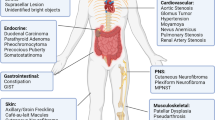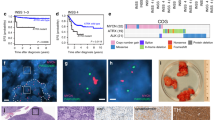Abstract
Inactivation of the neurofibromatosis-1 (NF1) gene de-regulates RAS and cooperates with mutation or loss of the p53 tumor suppressor to induce tumorigenesis. p19ARF acts upstream of p53 in an oncogene checkpoint to induce apoptosis in response to activated RAS and other factors that stimulate proliferation. Therefore, we bred p19ARF−/− to NF1+/− mice to determine if loss of these genes collaborates in tumorigenesis. As expected from the embryonic lethality of NF1 null mice, no mice lacking both p19ARF and NF1 were born. Unexpectedly, the loss of one allele of NF1 did not greatly shorten the time to tumor formation in a p19ARF null background. The tumor types observed were characteristic of p19ARF null animals, not those associated with neurofibromatosis or those observed with NF1+/−/p53+/− mice. However, seven out of 12 animals developed multiple tumors, some with metastases. This multiple tumor phenotype was not previously observed with p19ARF-null mice and suggests a distinct form of cooperation between the loss of these tumor suppressors.
This is a preview of subscription content, access via your institution
Access options
Subscribe to this journal
Receive 50 print issues and online access
$259.00 per year
only $5.18 per issue
Buy this article
- Purchase on Springer Link
- Instant access to full article PDF
Prices may be subject to local taxes which are calculated during checkout



Similar content being viewed by others
References
Brannan CI, Perkins AS, Vogel KS, Ratner N, Nordlund ML, Reid SW, Buchberg AM, Jenkins NA, Parada LF, Copeland NG . 1994 Genes Dev. 8: 1019–1029
Cichowski K, Shih TS, Schmitt E, Santiago S, Reilly K, McLaughlin ME, Bronson RT, Jacks T . 1999 Science 286: 2172–2176
DeClue JE, Papageorge AG, Fletcher JA, Diehl SR, Ratner N, Vass WC, Lowy DR . 1992 Cell 69: 265–273
Eischen CM, Weber JD, Roussel MF, Sherr CJ, Cleveland JL . 1999 Genes Dev. 13: 2658–2669
Gutmann DH, Loehr A, Zhang Y, Kim J, Henkemeyer M, Cashen A . 1999 Oncogene 18: 4450–4459
Hiatt KK, Ingram DA, Zhang Y, Bollag G, Clapp DW . 2001 J. Biol. Chem. 276: 7240–7245
Ingram DA, Yang FC, Travers JB, Wenning MJ, Hiatt K, New S, Hood A, Shannon K, Williams DA, Clapp DW . 2000 J. Exp. Med. 191: 181–188
Jacks T, Shih TS, Schmitt EM, Bronson RT, Bernards A, Weinberg RA . 1994 Nat. Genet. 7: 353–361
Kamijo T, Bodner S, van de Kamp E, Randle DH, Sherr CJ . 1999 Cancer Res. 59: 2217–2222
Kamijo T, Zindy F, Roussel MF, Quelle DE, Downing JR, Ashmun RA, Grosveld G, Sherr CJ . 1997 Cell 91: 649–659
Krimpenfort P, Quon KC, Mooi WJ, Loonstra A, Berns A . 2001 Nature 413: 83–86
Largaespada DA, Brannan CI, Jenkins NA, Copeland NG . 1996 Nat. Genet. 12: 137–143
Lin AW, Lowe SW . 2001 Proc. Natl. Acad. Sci. USA 98: 5025–5030
Nip J, Strom DK, Eischen CM, Cleveland JL, Zambetti GP, Hiebert SW . 2001 Oncogene 20: 910–920
Quintanilla M, Brown K, Ramsden M, Balmain A . 1986 Nature 322: 78–80
Sharpless NE, Bardeesy N, Lee KH, Carrasco D, Castrillon DH, Aguirre AJ, Wu EA, Horner JW, DePinho RA . 2001 Nature 413: 86–91
Sherr CJ, Weber JD . 2000 Curr. Opin. Genet. Dev. 10: 94–99
Side L, Taylor B, Cayouette M, Conner E, Thompson P, Luce M, Shannon K . 1997 N. Engl. J. Med. 336: 1713–1720
Side LE, Emanuel PD, Taylor B, Franklin J, Thompson P, Castleberry RP, Shannon KM . 1998 Blood 92: 267–272
Vogel KS, Klesse LJ, Velasco-Miguel S, Meyers K, Rushing EJ, Parada LF . 1999 Science 286: 2176–2179
Zhang Y, Taylor BR, Shannon K, Clapp DW . 2001 J. Clin. Invest. 108: 709–715
Zhu Y, Parada LF . 2001 Exp. Cell Res. 264: 19–28
Acknowledgements
We thank the members of the Hiebert lab and Wade Clapp for helpful discussions and encouragement, Drs Neal Copeland and Nancy Jenkins for the NF1 heterozygous mice, Yue Hou and Scott Luce for expert technical assistance, and the Vanderbilt-Ingram Cancer Center sequencing facility and mouse necropsy core for support. Special thanks to Kay Washington and Roy Jensen for aid in the pathological analysis of the mice. This work was supported by National Institutes of Health (NIH) grant RO1-CA87549, a Center grant from the National Cancer Institute (CA68485), the Vanderbilt-Ingram Cancer Center.
Author information
Authors and Affiliations
Corresponding author
Rights and permissions
About this article
Cite this article
King, D., Yang, G., Thompson, M. et al. Loss of neurofibromatosis-1 and p19ARF cooperate to induce a multiple tumor phenotype. Oncogene 21, 4978–4982 (2002). https://doi.org/10.1038/sj.onc.1205632
Received:
Revised:
Accepted:
Published:
Issue Date:
DOI: https://doi.org/10.1038/sj.onc.1205632
Keywords
This article is cited by
-
Translating current basic research into future therapies for neurofibromatosis type 1
British Journal of Cancer (2020)
-
Molecular mechanisms promoting the pathogenesis of Schwann cell neoplasms
Acta Neuropathologica (2012)
-
Neurofibromatosis type 1 — a model for nervous system tumour formation?
Nature Reviews Cancer (2005)



